Assignment: Critical Analysis of Healthy Restaurant Business Plan
VerifiedAdded on 2020/05/28
|21
|4024
|190
Report
AI Summary
This report presents a critical analysis of a healthy restaurant business plan, focusing on the potential for establishing such a business in London. The study examines the growth of the healthy restaurant industry, emphasizing the increasing consumer demand for natural and healthy food options. It involves a survey of 62 random people in London, using a questionnaire to collect data on customer preferences, demographics, and spending habits. The report includes frequency tables, bar charts, and box plots to analyze the collected data. The analysis covers aspects such as preferred restaurant types, reasons for dining at healthy restaurants, menu preferences, desired price ranges, and factors influencing customer loyalty. The report aims to determine the feasibility of opening an independent organic restaurant in London, considering the competitive market and the importance of a well-defined business plan. The findings provide insights into the marketing strategies, sales forecasts, and customer service requirements necessary for the success of a healthy restaurant in the UK.

Running Head: ASSIGNMENT OF CRITICAL ANALYSIS
Healthy Restaurant Business Plan
Name of the Student:
Name of the University:
Author’s Note:
Healthy Restaurant Business Plan
Name of the Student:
Name of the University:
Author’s Note:
Paraphrase This Document
Need a fresh take? Get an instant paraphrase of this document with our AI Paraphraser

1ASSIGNMENT OF CRITICAL ANALYSIS
Executive Summary
This research study was carried out for determining if it is possible to inaugurate a healthy restaurant in London. The healthy restaurant industry
has experienced incredible development in the previous two decades. Healthy restaurants embrace improved quality, healthy ingredients and
remuneration of achieving the support of customers concerned with eating well and preserving the surrounding environment. The requirement
for natural and healthy foods is a well-documented customer-driven trend that is nestling into an increasing number of independent restaurants.
Survey indicates that lots of consumers buy healthy foods because of professed health and nutrition benefits of healthy products. For making
helpful comparisons between healthy and traditional restaurants’ food quality and cleanliness should also be granted.
Executive Summary
This research study was carried out for determining if it is possible to inaugurate a healthy restaurant in London. The healthy restaurant industry
has experienced incredible development in the previous two decades. Healthy restaurants embrace improved quality, healthy ingredients and
remuneration of achieving the support of customers concerned with eating well and preserving the surrounding environment. The requirement
for natural and healthy foods is a well-documented customer-driven trend that is nestling into an increasing number of independent restaurants.
Survey indicates that lots of consumers buy healthy foods because of professed health and nutrition benefits of healthy products. For making
helpful comparisons between healthy and traditional restaurants’ food quality and cleanliness should also be granted.
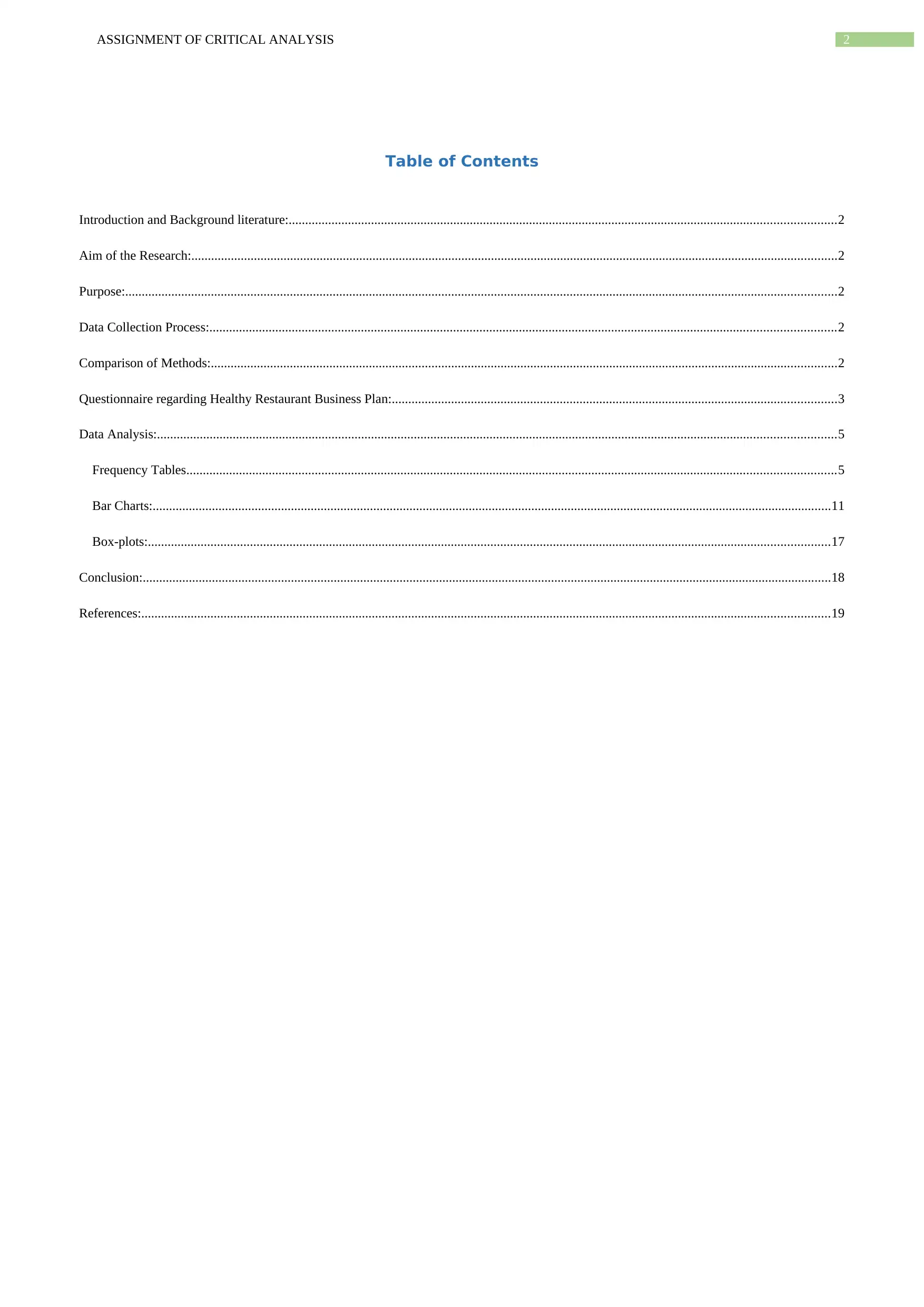
2ASSIGNMENT OF CRITICAL ANALYSIS
Table of Contents
Introduction and Background literature:......................................................................................................................................................................2
Aim of the Research:....................................................................................................................................................................................................2
Purpose:........................................................................................................................................................................................................................2
Data Collection Process:..............................................................................................................................................................................................2
Comparison of Methods:..............................................................................................................................................................................................2
Questionnaire regarding Healthy Restaurant Business Plan:.......................................................................................................................................3
Data Analysis:..............................................................................................................................................................................................................5
Frequency Tables.....................................................................................................................................................................................................5
Bar Charts:..............................................................................................................................................................................................................11
Box-plots:...............................................................................................................................................................................................................17
Conclusion:.................................................................................................................................................................................................................18
References:.................................................................................................................................................................................................................19
Table of Contents
Introduction and Background literature:......................................................................................................................................................................2
Aim of the Research:....................................................................................................................................................................................................2
Purpose:........................................................................................................................................................................................................................2
Data Collection Process:..............................................................................................................................................................................................2
Comparison of Methods:..............................................................................................................................................................................................2
Questionnaire regarding Healthy Restaurant Business Plan:.......................................................................................................................................3
Data Analysis:..............................................................................................................................................................................................................5
Frequency Tables.....................................................................................................................................................................................................5
Bar Charts:..............................................................................................................................................................................................................11
Box-plots:...............................................................................................................................................................................................................17
Conclusion:.................................................................................................................................................................................................................18
References:.................................................................................................................................................................................................................19
⊘ This is a preview!⊘
Do you want full access?
Subscribe today to unlock all pages.

Trusted by 1+ million students worldwide
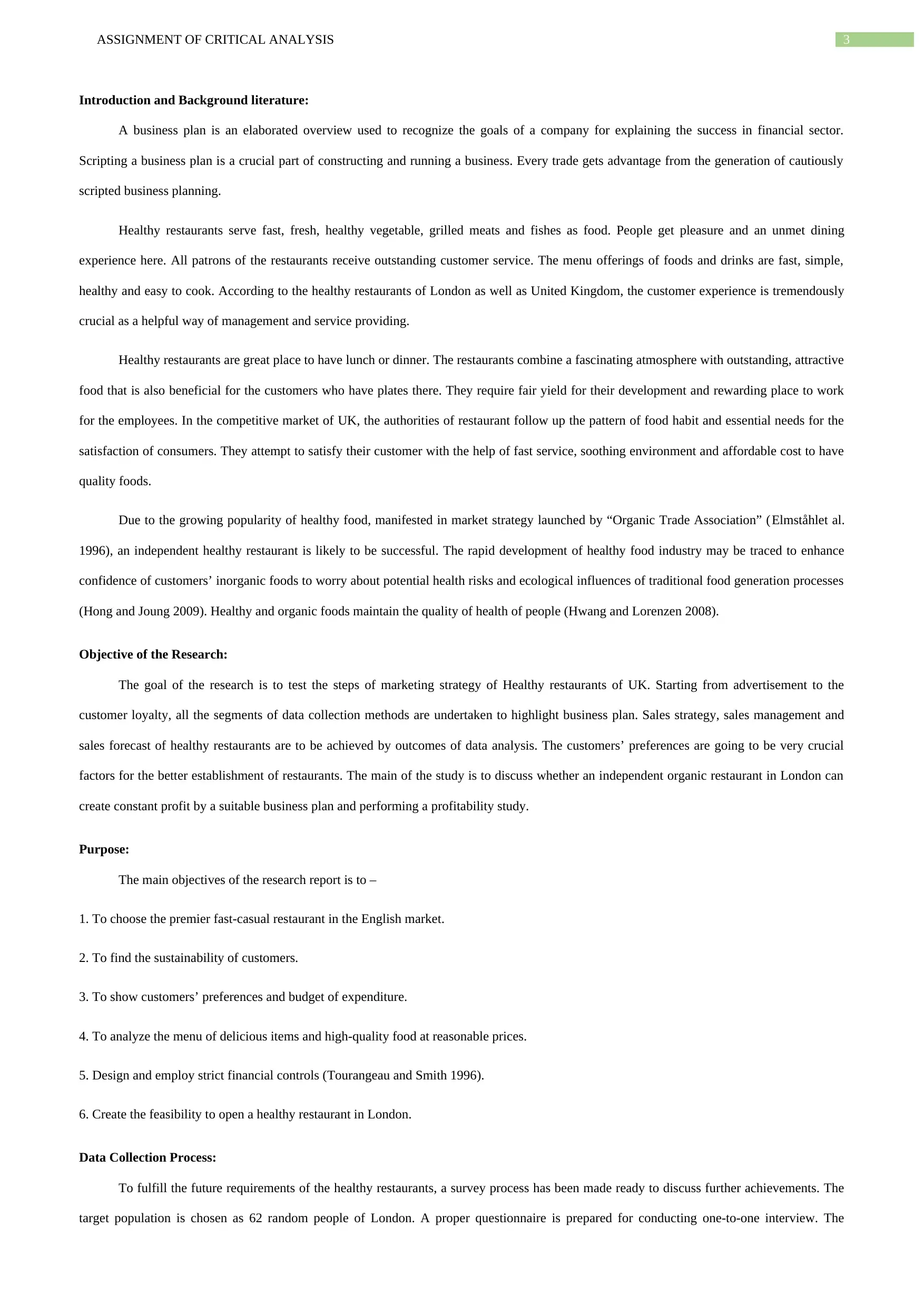
3ASSIGNMENT OF CRITICAL ANALYSIS
Introduction and Background literature:
A business plan is an elaborated overview used to recognize the goals of a company for explaining the success in financial sector.
Scripting a business plan is a crucial part of constructing and running a business. Every trade gets advantage from the generation of cautiously
scripted business planning.
Healthy restaurants serve fast, fresh, healthy vegetable, grilled meats and fishes as food. People get pleasure and an unmet dining
experience here. All patrons of the restaurants receive outstanding customer service. The menu offerings of foods and drinks are fast, simple,
healthy and easy to cook. According to the healthy restaurants of London as well as United Kingdom, the customer experience is tremendously
crucial as a helpful way of management and service providing.
Healthy restaurants are great place to have lunch or dinner. The restaurants combine a fascinating atmosphere with outstanding, attractive
food that is also beneficial for the customers who have plates there. They require fair yield for their development and rewarding place to work
for the employees. In the competitive market of UK, the authorities of restaurant follow up the pattern of food habit and essential needs for the
satisfaction of consumers. They attempt to satisfy their customer with the help of fast service, soothing environment and affordable cost to have
quality foods.
Due to the growing popularity of healthy food, manifested in market strategy launched by “Organic Trade Association” (Elmståhlet al.
1996), an independent healthy restaurant is likely to be successful. The rapid development of healthy food industry may be traced to enhance
confidence of customers’ inorganic foods to worry about potential health risks and ecological influences of traditional food generation processes
(Hong and Joung 2009). Healthy and organic foods maintain the quality of health of people (Hwang and Lorenzen 2008).
Objective of the Research:
The goal of the research is to test the steps of marketing strategy of Healthy restaurants of UK. Starting from advertisement to the
customer loyalty, all the segments of data collection methods are undertaken to highlight business plan. Sales strategy, sales management and
sales forecast of healthy restaurants are to be achieved by outcomes of data analysis. The customers’ preferences are going to be very crucial
factors for the better establishment of restaurants. The main of the study is to discuss whether an independent organic restaurant in London can
create constant profit by a suitable business plan and performing a profitability study.
Purpose:
The main objectives of the research report is to –
1. To choose the premier fast-casual restaurant in the English market.
2. To find the sustainability of customers.
3. To show customers’ preferences and budget of expenditure.
4. To analyze the menu of delicious items and high-quality food at reasonable prices.
5. Design and employ strict financial controls (Tourangeau and Smith 1996).
6. Create the feasibility to open a healthy restaurant in London.
Data Collection Process:
To fulfill the future requirements of the healthy restaurants, a survey process has been made ready to discuss further achievements. The
target population is chosen as 62 random people of London. A proper questionnaire is prepared for conducting one-to-one interview. The
Introduction and Background literature:
A business plan is an elaborated overview used to recognize the goals of a company for explaining the success in financial sector.
Scripting a business plan is a crucial part of constructing and running a business. Every trade gets advantage from the generation of cautiously
scripted business planning.
Healthy restaurants serve fast, fresh, healthy vegetable, grilled meats and fishes as food. People get pleasure and an unmet dining
experience here. All patrons of the restaurants receive outstanding customer service. The menu offerings of foods and drinks are fast, simple,
healthy and easy to cook. According to the healthy restaurants of London as well as United Kingdom, the customer experience is tremendously
crucial as a helpful way of management and service providing.
Healthy restaurants are great place to have lunch or dinner. The restaurants combine a fascinating atmosphere with outstanding, attractive
food that is also beneficial for the customers who have plates there. They require fair yield for their development and rewarding place to work
for the employees. In the competitive market of UK, the authorities of restaurant follow up the pattern of food habit and essential needs for the
satisfaction of consumers. They attempt to satisfy their customer with the help of fast service, soothing environment and affordable cost to have
quality foods.
Due to the growing popularity of healthy food, manifested in market strategy launched by “Organic Trade Association” (Elmståhlet al.
1996), an independent healthy restaurant is likely to be successful. The rapid development of healthy food industry may be traced to enhance
confidence of customers’ inorganic foods to worry about potential health risks and ecological influences of traditional food generation processes
(Hong and Joung 2009). Healthy and organic foods maintain the quality of health of people (Hwang and Lorenzen 2008).
Objective of the Research:
The goal of the research is to test the steps of marketing strategy of Healthy restaurants of UK. Starting from advertisement to the
customer loyalty, all the segments of data collection methods are undertaken to highlight business plan. Sales strategy, sales management and
sales forecast of healthy restaurants are to be achieved by outcomes of data analysis. The customers’ preferences are going to be very crucial
factors for the better establishment of restaurants. The main of the study is to discuss whether an independent organic restaurant in London can
create constant profit by a suitable business plan and performing a profitability study.
Purpose:
The main objectives of the research report is to –
1. To choose the premier fast-casual restaurant in the English market.
2. To find the sustainability of customers.
3. To show customers’ preferences and budget of expenditure.
4. To analyze the menu of delicious items and high-quality food at reasonable prices.
5. Design and employ strict financial controls (Tourangeau and Smith 1996).
6. Create the feasibility to open a healthy restaurant in London.
Data Collection Process:
To fulfill the future requirements of the healthy restaurants, a survey process has been made ready to discuss further achievements. The
target population is chosen as 62 random people of London. A proper questionnaire is prepared for conducting one-to-one interview. The
Paraphrase This Document
Need a fresh take? Get an instant paraphrase of this document with our AI Paraphraser
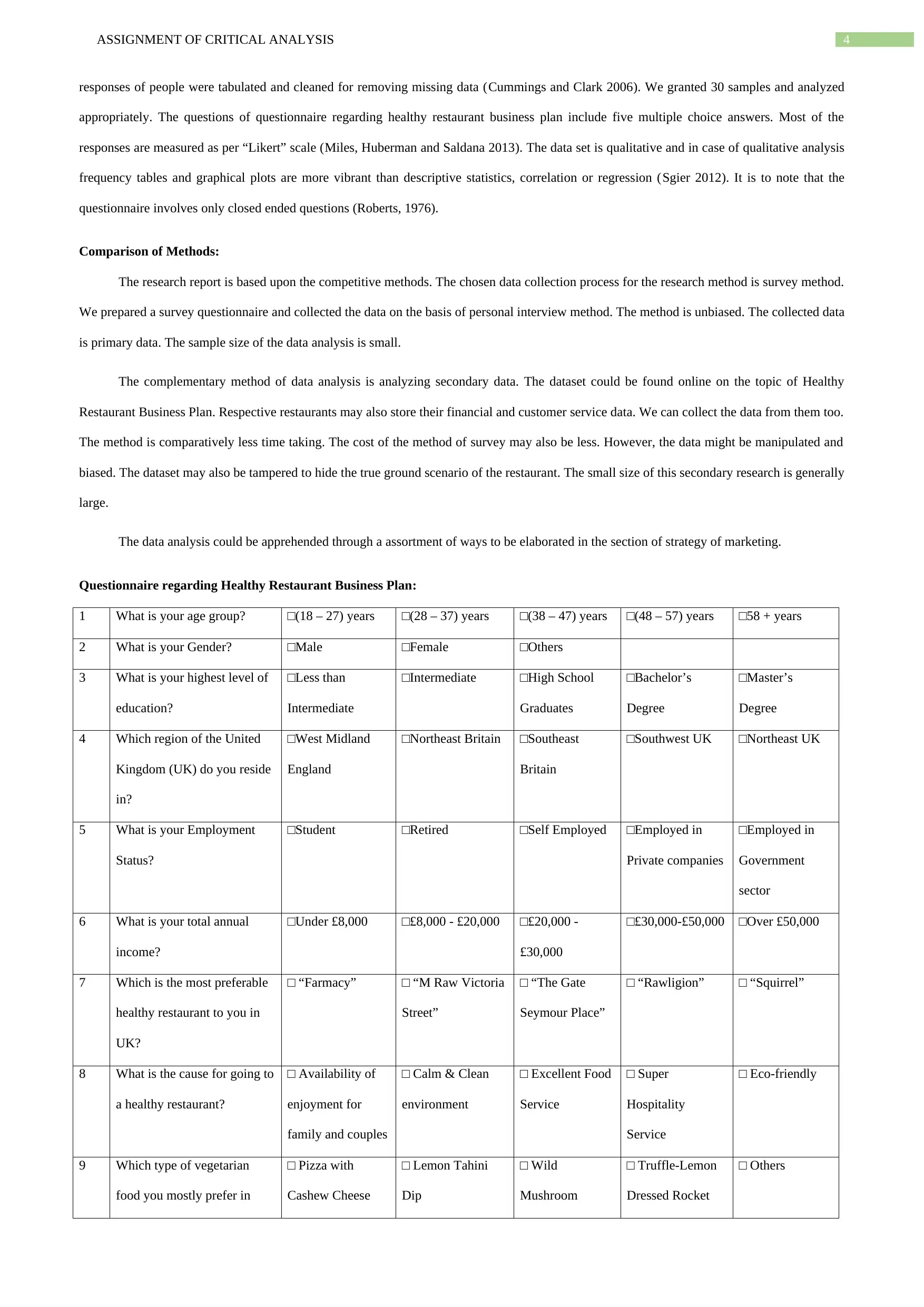
4ASSIGNMENT OF CRITICAL ANALYSIS
responses of people were tabulated and cleaned for removing missing data (Cummings and Clark 2006). We granted 30 samples and analyzed
appropriately. The questions of questionnaire regarding healthy restaurant business plan include five multiple choice answers. Most of the
responses are measured as per “Likert” scale (Miles, Huberman and Saldana 2013). The data set is qualitative and in case of qualitative analysis
frequency tables and graphical plots are more vibrant than descriptive statistics, correlation or regression (Sgier 2012). It is to note that the
questionnaire involves only closed ended questions (Roberts, 1976).
Comparison of Methods:
The research report is based upon the competitive methods. The chosen data collection process for the research method is survey method.
We prepared a survey questionnaire and collected the data on the basis of personal interview method. The method is unbiased. The collected data
is primary data. The sample size of the data analysis is small.
The complementary method of data analysis is analyzing secondary data. The dataset could be found online on the topic of Healthy
Restaurant Business Plan. Respective restaurants may also store their financial and customer service data. We can collect the data from them too.
The method is comparatively less time taking. The cost of the method of survey may also be less. However, the data might be manipulated and
biased. The dataset may also be tampered to hide the true ground scenario of the restaurant. The small size of this secondary research is generally
large.
The data analysis could be apprehended through a assortment of ways to be elaborated in the section of strategy of marketing.
Questionnaire regarding Healthy Restaurant Business Plan:
1 What is your age group? □(18 – 27) years □(28 – 37) years □(38 – 47) years □(48 – 57) years □58 + years
2 What is your Gender? □Male □Female □Others
3 What is your highest level of
education?
□Less than
Intermediate
□Intermediate □High School
Graduates
□Bachelor’s
Degree
□Master’s
Degree
4 Which region of the United
Kingdom (UK) do you reside
in?
□West Midland
England
□Northeast Britain □Southeast
Britain
□Southwest UK □Northeast UK
5 What is your Employment
Status?
□Student □Retired □Self Employed □Employed in
Private companies
□Employed in
Government
sector
6 What is your total annual
income?
□Under £8,000 □£8,000 - £20,000 □£20,000 -
£30,000
□£30,000-£50,000 □Over £50,000
7 Which is the most preferable
healthy restaurant to you in
UK?
□ “Farmacy” □ “M Raw Victoria
Street”
□ “The Gate
Seymour Place”
□ “Rawligion” □ “Squirrel”
8 What is the cause for going to
a healthy restaurant?
□ Availability of
enjoyment for
family and couples
□ Calm & Clean
environment
□ Excellent Food
Service
□ Super
Hospitality
Service
□ Eco-friendly
9 Which type of vegetarian
food you mostly prefer in
□ Pizza with
Cashew Cheese
□ Lemon Tahini
Dip
□ Wild
Mushroom
□ Truffle-Lemon
Dressed Rocket
□ Others
responses of people were tabulated and cleaned for removing missing data (Cummings and Clark 2006). We granted 30 samples and analyzed
appropriately. The questions of questionnaire regarding healthy restaurant business plan include five multiple choice answers. Most of the
responses are measured as per “Likert” scale (Miles, Huberman and Saldana 2013). The data set is qualitative and in case of qualitative analysis
frequency tables and graphical plots are more vibrant than descriptive statistics, correlation or regression (Sgier 2012). It is to note that the
questionnaire involves only closed ended questions (Roberts, 1976).
Comparison of Methods:
The research report is based upon the competitive methods. The chosen data collection process for the research method is survey method.
We prepared a survey questionnaire and collected the data on the basis of personal interview method. The method is unbiased. The collected data
is primary data. The sample size of the data analysis is small.
The complementary method of data analysis is analyzing secondary data. The dataset could be found online on the topic of Healthy
Restaurant Business Plan. Respective restaurants may also store their financial and customer service data. We can collect the data from them too.
The method is comparatively less time taking. The cost of the method of survey may also be less. However, the data might be manipulated and
biased. The dataset may also be tampered to hide the true ground scenario of the restaurant. The small size of this secondary research is generally
large.
The data analysis could be apprehended through a assortment of ways to be elaborated in the section of strategy of marketing.
Questionnaire regarding Healthy Restaurant Business Plan:
1 What is your age group? □(18 – 27) years □(28 – 37) years □(38 – 47) years □(48 – 57) years □58 + years
2 What is your Gender? □Male □Female □Others
3 What is your highest level of
education?
□Less than
Intermediate
□Intermediate □High School
Graduates
□Bachelor’s
Degree
□Master’s
Degree
4 Which region of the United
Kingdom (UK) do you reside
in?
□West Midland
England
□Northeast Britain □Southeast
Britain
□Southwest UK □Northeast UK
5 What is your Employment
Status?
□Student □Retired □Self Employed □Employed in
Private companies
□Employed in
Government
sector
6 What is your total annual
income?
□Under £8,000 □£8,000 - £20,000 □£20,000 -
£30,000
□£30,000-£50,000 □Over £50,000
7 Which is the most preferable
healthy restaurant to you in
UK?
□ “Farmacy” □ “M Raw Victoria
Street”
□ “The Gate
Seymour Place”
□ “Rawligion” □ “Squirrel”
8 What is the cause for going to
a healthy restaurant?
□ Availability of
enjoyment for
family and couples
□ Calm & Clean
environment
□ Excellent Food
Service
□ Super
Hospitality
Service
□ Eco-friendly
9 Which type of vegetarian
food you mostly prefer in
□ Pizza with
Cashew Cheese
□ Lemon Tahini
Dip
□ Wild
Mushroom
□ Truffle-Lemon
Dressed Rocket
□ Others
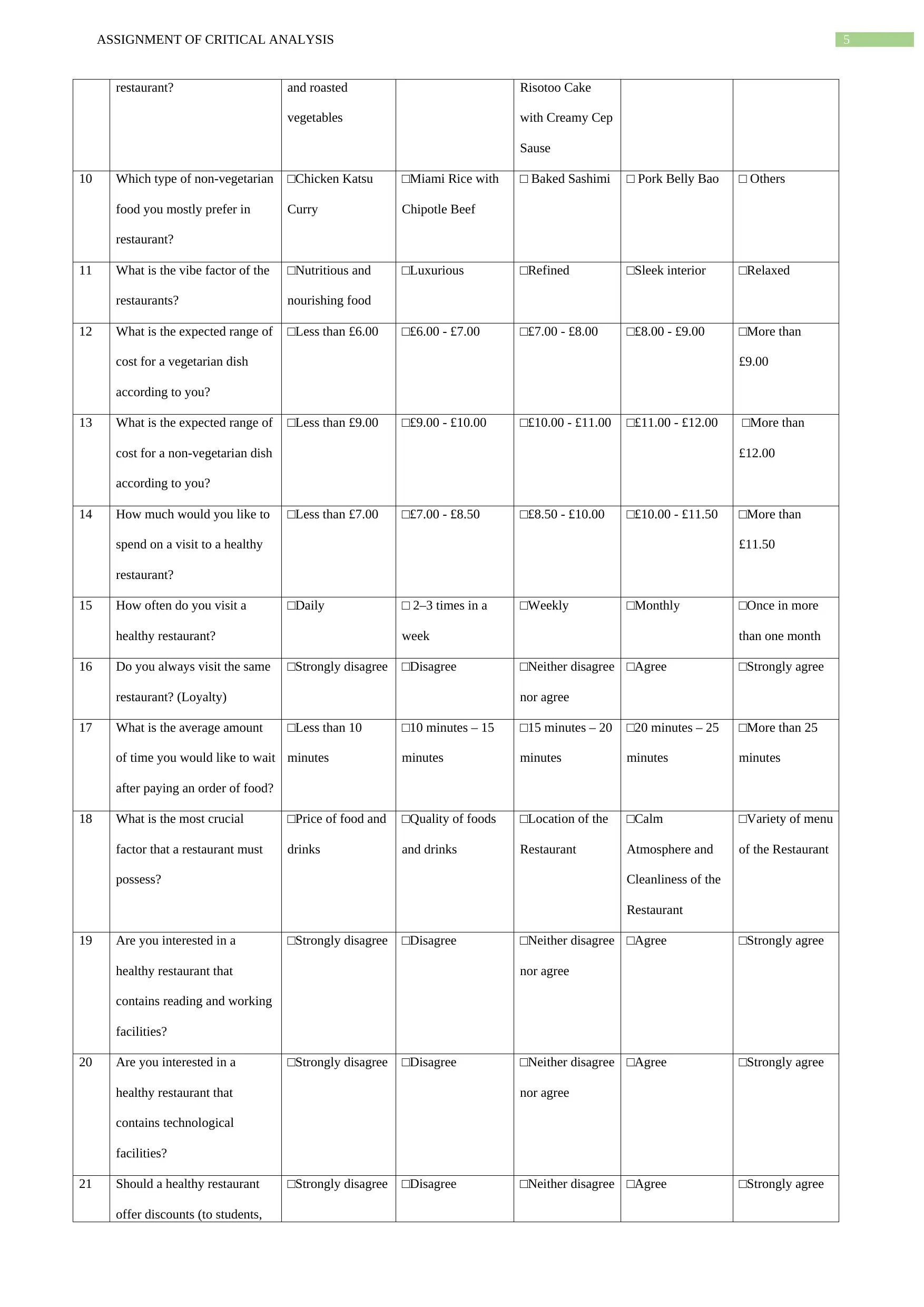
5ASSIGNMENT OF CRITICAL ANALYSIS
restaurant? and roasted
vegetables
Risotoo Cake
with Creamy Cep
Sause
10 Which type of non-vegetarian
food you mostly prefer in
restaurant?
□Chicken Katsu
Curry
□Miami Rice with
Chipotle Beef
□ Baked Sashimi □ Pork Belly Bao □ Others
11 What is the vibe factor of the
restaurants?
□Nutritious and
nourishing food
□Luxurious □Refined □Sleek interior □Relaxed
12 What is the expected range of
cost for a vegetarian dish
according to you?
□Less than £6.00 □£6.00 - £7.00 □£7.00 - £8.00 □£8.00 - £9.00 □More than
£9.00
13 What is the expected range of
cost for a non-vegetarian dish
according to you?
□Less than £9.00 □£9.00 - £10.00 □£10.00 - £11.00 □£11.00 - £12.00 □More than
£12.00
14 How much would you like to
spend on a visit to a healthy
restaurant?
□Less than £7.00 □£7.00 - £8.50 □£8.50 - £10.00 □£10.00 - £11.50 □More than
£11.50
15 How often do you visit a
healthy restaurant?
□Daily □ 2–3 times in a
week
□Weekly □Monthly □Once in more
than one month
16 Do you always visit the same
restaurant? (Loyalty)
□Strongly disagree □Disagree □Neither disagree
nor agree
□Agree □Strongly agree
17 What is the average amount
of time you would like to wait
after paying an order of food?
□Less than 10
minutes
□10 minutes – 15
minutes
□15 minutes – 20
minutes
□20 minutes – 25
minutes
□More than 25
minutes
18 What is the most crucial
factor that a restaurant must
possess?
□Price of food and
drinks
□Quality of foods
and drinks
□Location of the
Restaurant
□Calm
Atmosphere and
Cleanliness of the
Restaurant
□Variety of menu
of the Restaurant
19 Are you interested in a
healthy restaurant that
contains reading and working
facilities?
□Strongly disagree □Disagree □Neither disagree
nor agree
□Agree □Strongly agree
20 Are you interested in a
healthy restaurant that
contains technological
facilities?
□Strongly disagree □Disagree □Neither disagree
nor agree
□Agree □Strongly agree
21 Should a healthy restaurant
offer discounts (to students,
□Strongly disagree □Disagree □Neither disagree □Agree □Strongly agree
restaurant? and roasted
vegetables
Risotoo Cake
with Creamy Cep
Sause
10 Which type of non-vegetarian
food you mostly prefer in
restaurant?
□Chicken Katsu
Curry
□Miami Rice with
Chipotle Beef
□ Baked Sashimi □ Pork Belly Bao □ Others
11 What is the vibe factor of the
restaurants?
□Nutritious and
nourishing food
□Luxurious □Refined □Sleek interior □Relaxed
12 What is the expected range of
cost for a vegetarian dish
according to you?
□Less than £6.00 □£6.00 - £7.00 □£7.00 - £8.00 □£8.00 - £9.00 □More than
£9.00
13 What is the expected range of
cost for a non-vegetarian dish
according to you?
□Less than £9.00 □£9.00 - £10.00 □£10.00 - £11.00 □£11.00 - £12.00 □More than
£12.00
14 How much would you like to
spend on a visit to a healthy
restaurant?
□Less than £7.00 □£7.00 - £8.50 □£8.50 - £10.00 □£10.00 - £11.50 □More than
£11.50
15 How often do you visit a
healthy restaurant?
□Daily □ 2–3 times in a
week
□Weekly □Monthly □Once in more
than one month
16 Do you always visit the same
restaurant? (Loyalty)
□Strongly disagree □Disagree □Neither disagree
nor agree
□Agree □Strongly agree
17 What is the average amount
of time you would like to wait
after paying an order of food?
□Less than 10
minutes
□10 minutes – 15
minutes
□15 minutes – 20
minutes
□20 minutes – 25
minutes
□More than 25
minutes
18 What is the most crucial
factor that a restaurant must
possess?
□Price of food and
drinks
□Quality of foods
and drinks
□Location of the
Restaurant
□Calm
Atmosphere and
Cleanliness of the
Restaurant
□Variety of menu
of the Restaurant
19 Are you interested in a
healthy restaurant that
contains reading and working
facilities?
□Strongly disagree □Disagree □Neither disagree
nor agree
□Agree □Strongly agree
20 Are you interested in a
healthy restaurant that
contains technological
facilities?
□Strongly disagree □Disagree □Neither disagree
nor agree
□Agree □Strongly agree
21 Should a healthy restaurant
offer discounts (to students,
□Strongly disagree □Disagree □Neither disagree □Agree □Strongly agree
⊘ This is a preview!⊘
Do you want full access?
Subscribe today to unlock all pages.

Trusted by 1+ million students worldwide
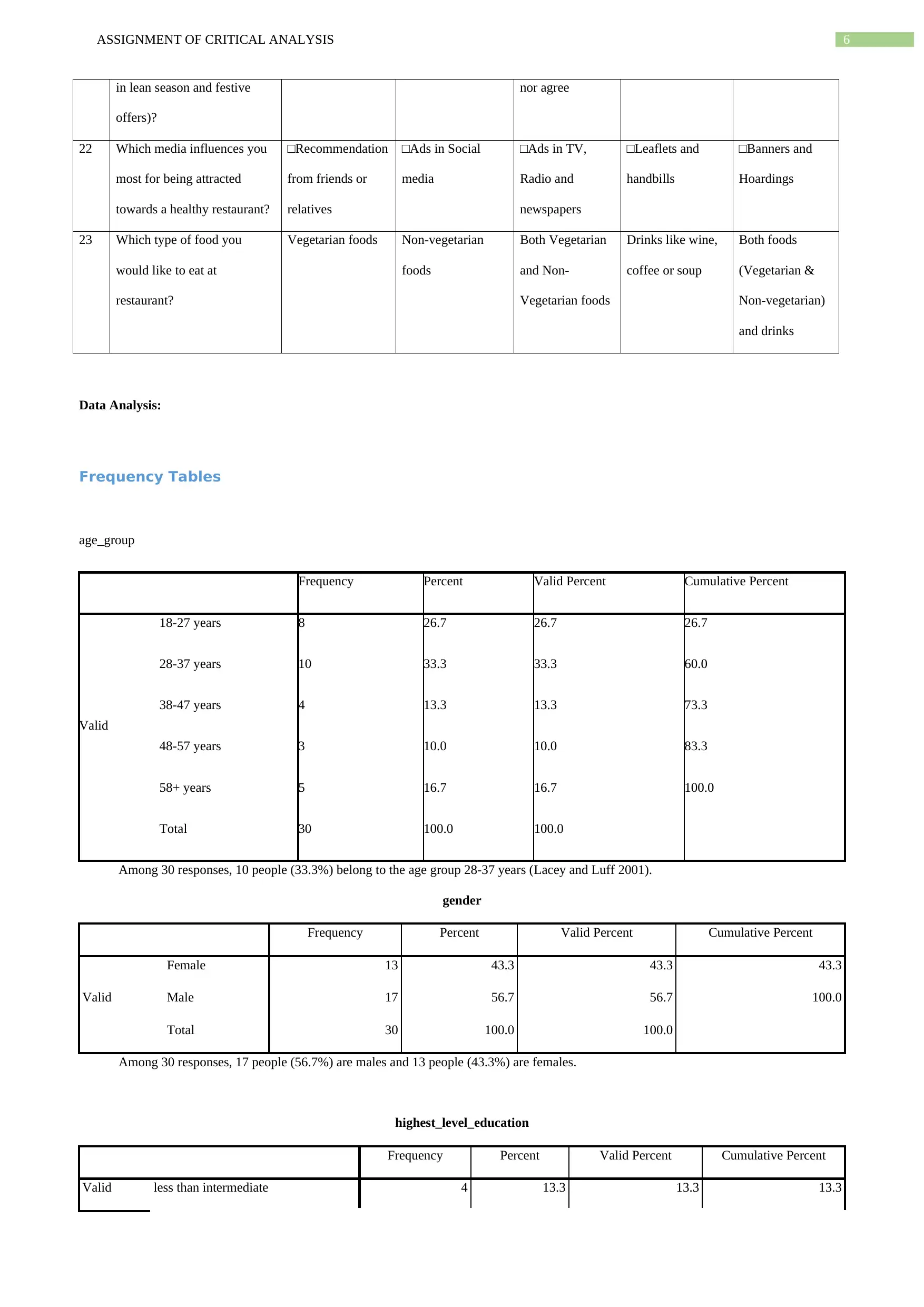
6ASSIGNMENT OF CRITICAL ANALYSIS
in lean season and festive
offers)?
nor agree
22 Which media influences you
most for being attracted
towards a healthy restaurant?
□Recommendation
from friends or
relatives
□Ads in Social
media
□Ads in TV,
Radio and
newspapers
□Leaflets and
handbills
□Banners and
Hoardings
23 Which type of food you
would like to eat at
restaurant?
Vegetarian foods Non-vegetarian
foods
Both Vegetarian
and Non-
Vegetarian foods
Drinks like wine,
coffee or soup
Both foods
(Vegetarian &
Non-vegetarian)
and drinks
Data Analysis:
Frequency Tables
age_group
Frequency Percent Valid Percent Cumulative Percent
Valid
18-27 years 8 26.7 26.7 26.7
28-37 years 10 33.3 33.3 60.0
38-47 years 4 13.3 13.3 73.3
48-57 years 3 10.0 10.0 83.3
58+ years 5 16.7 16.7 100.0
Total 30 100.0 100.0
Among 30 responses, 10 people (33.3%) belong to the age group 28-37 years (Lacey and Luff 2001).
gender
Frequency Percent Valid Percent Cumulative Percent
Valid
Female 13 43.3 43.3 43.3
Male 17 56.7 56.7 100.0
Total 30 100.0 100.0
Among 30 responses, 17 people (56.7%) are males and 13 people (43.3%) are females.
highest_level_education
Frequency Percent Valid Percent Cumulative Percent
Valid less than intermediate 4 13.3 13.3 13.3
in lean season and festive
offers)?
nor agree
22 Which media influences you
most for being attracted
towards a healthy restaurant?
□Recommendation
from friends or
relatives
□Ads in Social
media
□Ads in TV,
Radio and
newspapers
□Leaflets and
handbills
□Banners and
Hoardings
23 Which type of food you
would like to eat at
restaurant?
Vegetarian foods Non-vegetarian
foods
Both Vegetarian
and Non-
Vegetarian foods
Drinks like wine,
coffee or soup
Both foods
(Vegetarian &
Non-vegetarian)
and drinks
Data Analysis:
Frequency Tables
age_group
Frequency Percent Valid Percent Cumulative Percent
Valid
18-27 years 8 26.7 26.7 26.7
28-37 years 10 33.3 33.3 60.0
38-47 years 4 13.3 13.3 73.3
48-57 years 3 10.0 10.0 83.3
58+ years 5 16.7 16.7 100.0
Total 30 100.0 100.0
Among 30 responses, 10 people (33.3%) belong to the age group 28-37 years (Lacey and Luff 2001).
gender
Frequency Percent Valid Percent Cumulative Percent
Valid
Female 13 43.3 43.3 43.3
Male 17 56.7 56.7 100.0
Total 30 100.0 100.0
Among 30 responses, 17 people (56.7%) are males and 13 people (43.3%) are females.
highest_level_education
Frequency Percent Valid Percent Cumulative Percent
Valid less than intermediate 4 13.3 13.3 13.3
Paraphrase This Document
Need a fresh take? Get an instant paraphrase of this document with our AI Paraphraser
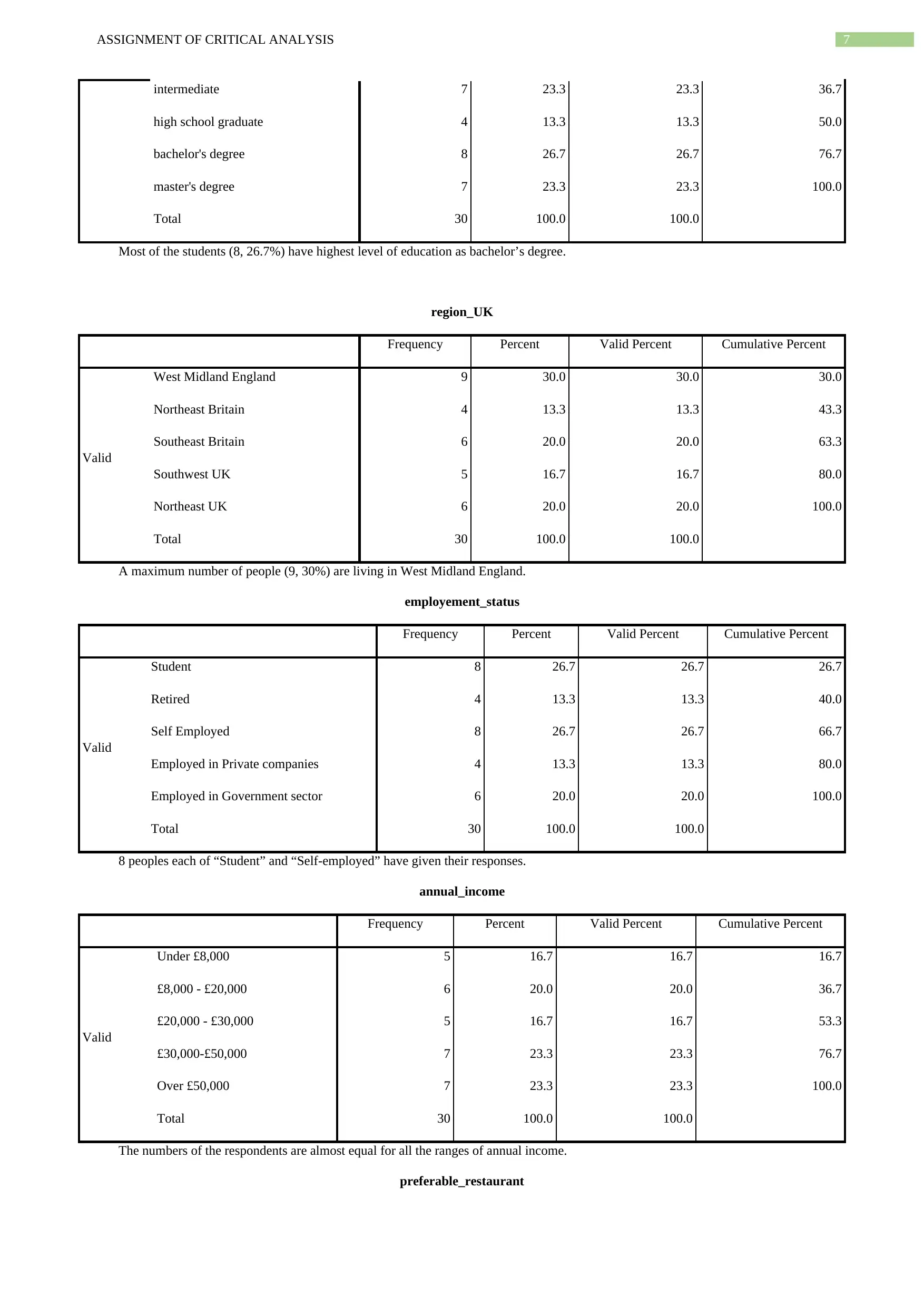
7ASSIGNMENT OF CRITICAL ANALYSIS
intermediate 7 23.3 23.3 36.7
high school graduate 4 13.3 13.3 50.0
bachelor's degree 8 26.7 26.7 76.7
master's degree 7 23.3 23.3 100.0
Total 30 100.0 100.0
Most of the students (8, 26.7%) have highest level of education as bachelor’s degree.
region_UK
Frequency Percent Valid Percent Cumulative Percent
Valid
West Midland England 9 30.0 30.0 30.0
Northeast Britain 4 13.3 13.3 43.3
Southeast Britain 6 20.0 20.0 63.3
Southwest UK 5 16.7 16.7 80.0
Northeast UK 6 20.0 20.0 100.0
Total 30 100.0 100.0
A maximum number of people (9, 30%) are living in West Midland England.
employement_status
Frequency Percent Valid Percent Cumulative Percent
Valid
Student 8 26.7 26.7 26.7
Retired 4 13.3 13.3 40.0
Self Employed 8 26.7 26.7 66.7
Employed in Private companies 4 13.3 13.3 80.0
Employed in Government sector 6 20.0 20.0 100.0
Total 30 100.0 100.0
8 peoples each of “Student” and “Self-employed” have given their responses.
annual_income
Frequency Percent Valid Percent Cumulative Percent
Valid
Under £8,000 5 16.7 16.7 16.7
£8,000 - £20,000 6 20.0 20.0 36.7
£20,000 - £30,000 5 16.7 16.7 53.3
£30,000-£50,000 7 23.3 23.3 76.7
Over £50,000 7 23.3 23.3 100.0
Total 30 100.0 100.0
The numbers of the respondents are almost equal for all the ranges of annual income.
preferable_restaurant
intermediate 7 23.3 23.3 36.7
high school graduate 4 13.3 13.3 50.0
bachelor's degree 8 26.7 26.7 76.7
master's degree 7 23.3 23.3 100.0
Total 30 100.0 100.0
Most of the students (8, 26.7%) have highest level of education as bachelor’s degree.
region_UK
Frequency Percent Valid Percent Cumulative Percent
Valid
West Midland England 9 30.0 30.0 30.0
Northeast Britain 4 13.3 13.3 43.3
Southeast Britain 6 20.0 20.0 63.3
Southwest UK 5 16.7 16.7 80.0
Northeast UK 6 20.0 20.0 100.0
Total 30 100.0 100.0
A maximum number of people (9, 30%) are living in West Midland England.
employement_status
Frequency Percent Valid Percent Cumulative Percent
Valid
Student 8 26.7 26.7 26.7
Retired 4 13.3 13.3 40.0
Self Employed 8 26.7 26.7 66.7
Employed in Private companies 4 13.3 13.3 80.0
Employed in Government sector 6 20.0 20.0 100.0
Total 30 100.0 100.0
8 peoples each of “Student” and “Self-employed” have given their responses.
annual_income
Frequency Percent Valid Percent Cumulative Percent
Valid
Under £8,000 5 16.7 16.7 16.7
£8,000 - £20,000 6 20.0 20.0 36.7
£20,000 - £30,000 5 16.7 16.7 53.3
£30,000-£50,000 7 23.3 23.3 76.7
Over £50,000 7 23.3 23.3 100.0
Total 30 100.0 100.0
The numbers of the respondents are almost equal for all the ranges of annual income.
preferable_restaurant
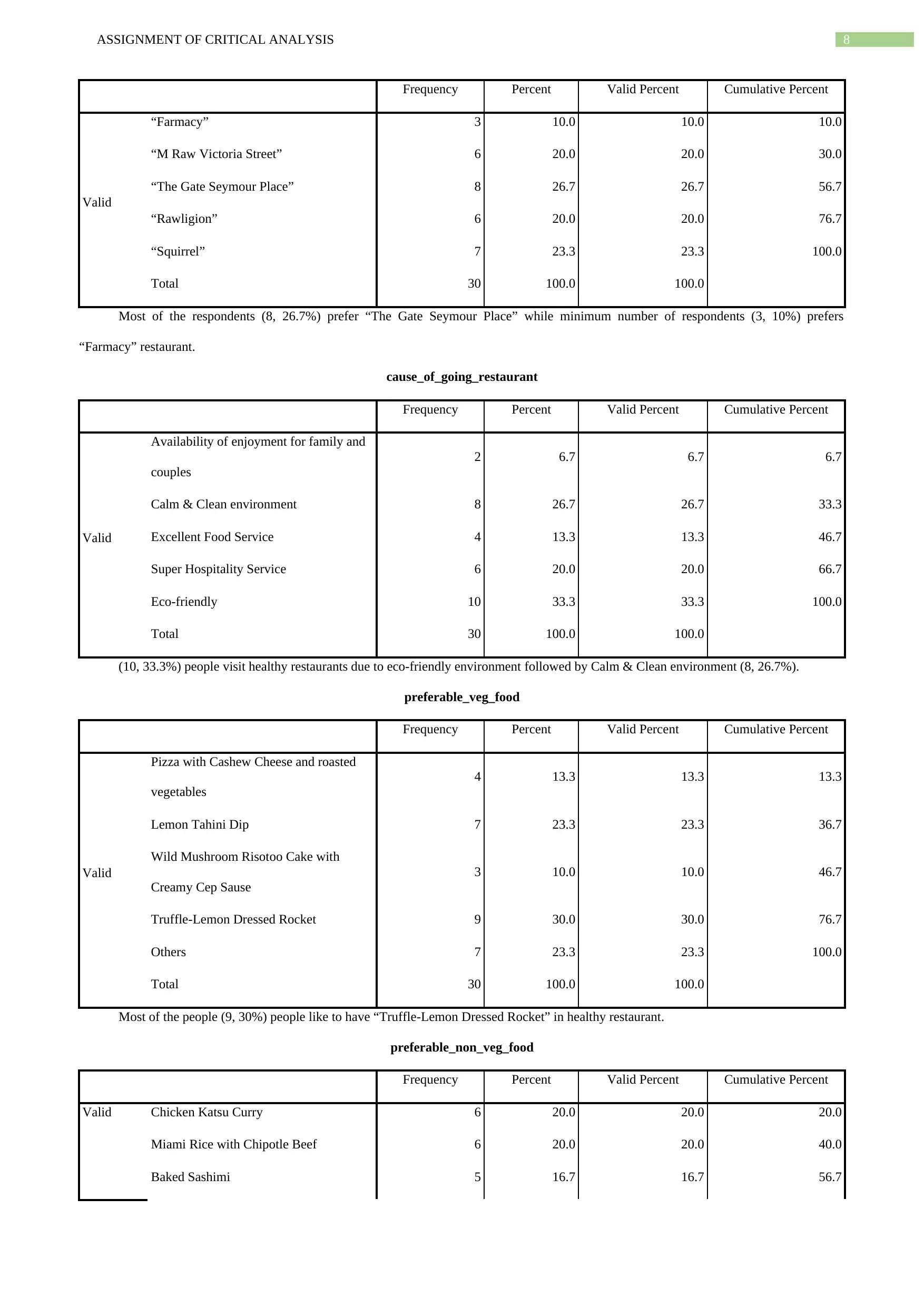
8ASSIGNMENT OF CRITICAL ANALYSIS
Frequency Percent Valid Percent Cumulative Percent
Valid
“Farmacy” 3 10.0 10.0 10.0
“M Raw Victoria Street” 6 20.0 20.0 30.0
“The Gate Seymour Place” 8 26.7 26.7 56.7
“Rawligion” 6 20.0 20.0 76.7
“Squirrel” 7 23.3 23.3 100.0
Total 30 100.0 100.0
Most of the respondents (8, 26.7%) prefer “The Gate Seymour Place” while minimum number of respondents (3, 10%) prefers
“Farmacy” restaurant.
cause_of_going_restaurant
Frequency Percent Valid Percent Cumulative Percent
Valid
Availability of enjoyment for family and
couples
2 6.7 6.7 6.7
Calm & Clean environment 8 26.7 26.7 33.3
Excellent Food Service 4 13.3 13.3 46.7
Super Hospitality Service 6 20.0 20.0 66.7
Eco-friendly 10 33.3 33.3 100.0
Total 30 100.0 100.0
(10, 33.3%) people visit healthy restaurants due to eco-friendly environment followed by Calm & Clean environment (8, 26.7%).
preferable_veg_food
Frequency Percent Valid Percent Cumulative Percent
Valid
Pizza with Cashew Cheese and roasted
vegetables
4 13.3 13.3 13.3
Lemon Tahini Dip 7 23.3 23.3 36.7
Wild Mushroom Risotoo Cake with
Creamy Cep Sause
3 10.0 10.0 46.7
Truffle-Lemon Dressed Rocket 9 30.0 30.0 76.7
Others 7 23.3 23.3 100.0
Total 30 100.0 100.0
Most of the people (9, 30%) people like to have “Truffle-Lemon Dressed Rocket” in healthy restaurant.
preferable_non_veg_food
Frequency Percent Valid Percent Cumulative Percent
Valid Chicken Katsu Curry 6 20.0 20.0 20.0
Miami Rice with Chipotle Beef 6 20.0 20.0 40.0
Baked Sashimi 5 16.7 16.7 56.7
Frequency Percent Valid Percent Cumulative Percent
Valid
“Farmacy” 3 10.0 10.0 10.0
“M Raw Victoria Street” 6 20.0 20.0 30.0
“The Gate Seymour Place” 8 26.7 26.7 56.7
“Rawligion” 6 20.0 20.0 76.7
“Squirrel” 7 23.3 23.3 100.0
Total 30 100.0 100.0
Most of the respondents (8, 26.7%) prefer “The Gate Seymour Place” while minimum number of respondents (3, 10%) prefers
“Farmacy” restaurant.
cause_of_going_restaurant
Frequency Percent Valid Percent Cumulative Percent
Valid
Availability of enjoyment for family and
couples
2 6.7 6.7 6.7
Calm & Clean environment 8 26.7 26.7 33.3
Excellent Food Service 4 13.3 13.3 46.7
Super Hospitality Service 6 20.0 20.0 66.7
Eco-friendly 10 33.3 33.3 100.0
Total 30 100.0 100.0
(10, 33.3%) people visit healthy restaurants due to eco-friendly environment followed by Calm & Clean environment (8, 26.7%).
preferable_veg_food
Frequency Percent Valid Percent Cumulative Percent
Valid
Pizza with Cashew Cheese and roasted
vegetables
4 13.3 13.3 13.3
Lemon Tahini Dip 7 23.3 23.3 36.7
Wild Mushroom Risotoo Cake with
Creamy Cep Sause
3 10.0 10.0 46.7
Truffle-Lemon Dressed Rocket 9 30.0 30.0 76.7
Others 7 23.3 23.3 100.0
Total 30 100.0 100.0
Most of the people (9, 30%) people like to have “Truffle-Lemon Dressed Rocket” in healthy restaurant.
preferable_non_veg_food
Frequency Percent Valid Percent Cumulative Percent
Valid Chicken Katsu Curry 6 20.0 20.0 20.0
Miami Rice with Chipotle Beef 6 20.0 20.0 40.0
Baked Sashimi 5 16.7 16.7 56.7
⊘ This is a preview!⊘
Do you want full access?
Subscribe today to unlock all pages.

Trusted by 1+ million students worldwide
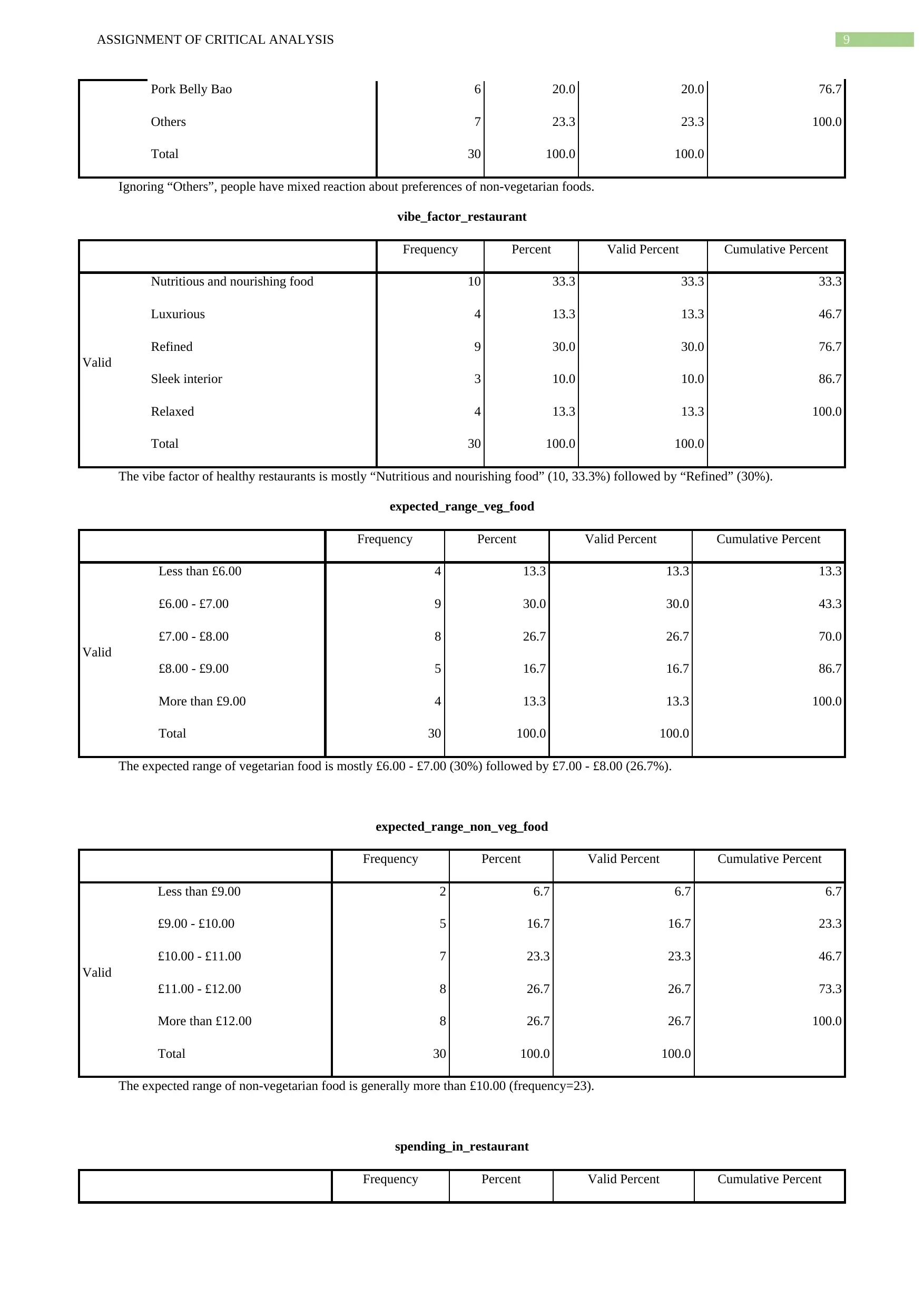
9ASSIGNMENT OF CRITICAL ANALYSIS
Pork Belly Bao 6 20.0 20.0 76.7
Others 7 23.3 23.3 100.0
Total 30 100.0 100.0
Ignoring “Others”, people have mixed reaction about preferences of non-vegetarian foods.
vibe_factor_restaurant
Frequency Percent Valid Percent Cumulative Percent
Valid
Nutritious and nourishing food 10 33.3 33.3 33.3
Luxurious 4 13.3 13.3 46.7
Refined 9 30.0 30.0 76.7
Sleek interior 3 10.0 10.0 86.7
Relaxed 4 13.3 13.3 100.0
Total 30 100.0 100.0
The vibe factor of healthy restaurants is mostly “Nutritious and nourishing food” (10, 33.3%) followed by “Refined” (30%).
expected_range_veg_food
Frequency Percent Valid Percent Cumulative Percent
Valid
Less than £6.00 4 13.3 13.3 13.3
£6.00 - £7.00 9 30.0 30.0 43.3
£7.00 - £8.00 8 26.7 26.7 70.0
£8.00 - £9.00 5 16.7 16.7 86.7
More than £9.00 4 13.3 13.3 100.0
Total 30 100.0 100.0
The expected range of vegetarian food is mostly £6.00 - £7.00 (30%) followed by £7.00 - £8.00 (26.7%).
expected_range_non_veg_food
Frequency Percent Valid Percent Cumulative Percent
Valid
Less than £9.00 2 6.7 6.7 6.7
£9.00 - £10.00 5 16.7 16.7 23.3
£10.00 - £11.00 7 23.3 23.3 46.7
£11.00 - £12.00 8 26.7 26.7 73.3
More than £12.00 8 26.7 26.7 100.0
Total 30 100.0 100.0
The expected range of non-vegetarian food is generally more than £10.00 (frequency=23).
spending_in_restaurant
Frequency Percent Valid Percent Cumulative Percent
Pork Belly Bao 6 20.0 20.0 76.7
Others 7 23.3 23.3 100.0
Total 30 100.0 100.0
Ignoring “Others”, people have mixed reaction about preferences of non-vegetarian foods.
vibe_factor_restaurant
Frequency Percent Valid Percent Cumulative Percent
Valid
Nutritious and nourishing food 10 33.3 33.3 33.3
Luxurious 4 13.3 13.3 46.7
Refined 9 30.0 30.0 76.7
Sleek interior 3 10.0 10.0 86.7
Relaxed 4 13.3 13.3 100.0
Total 30 100.0 100.0
The vibe factor of healthy restaurants is mostly “Nutritious and nourishing food” (10, 33.3%) followed by “Refined” (30%).
expected_range_veg_food
Frequency Percent Valid Percent Cumulative Percent
Valid
Less than £6.00 4 13.3 13.3 13.3
£6.00 - £7.00 9 30.0 30.0 43.3
£7.00 - £8.00 8 26.7 26.7 70.0
£8.00 - £9.00 5 16.7 16.7 86.7
More than £9.00 4 13.3 13.3 100.0
Total 30 100.0 100.0
The expected range of vegetarian food is mostly £6.00 - £7.00 (30%) followed by £7.00 - £8.00 (26.7%).
expected_range_non_veg_food
Frequency Percent Valid Percent Cumulative Percent
Valid
Less than £9.00 2 6.7 6.7 6.7
£9.00 - £10.00 5 16.7 16.7 23.3
£10.00 - £11.00 7 23.3 23.3 46.7
£11.00 - £12.00 8 26.7 26.7 73.3
More than £12.00 8 26.7 26.7 100.0
Total 30 100.0 100.0
The expected range of non-vegetarian food is generally more than £10.00 (frequency=23).
spending_in_restaurant
Frequency Percent Valid Percent Cumulative Percent
Paraphrase This Document
Need a fresh take? Get an instant paraphrase of this document with our AI Paraphraser
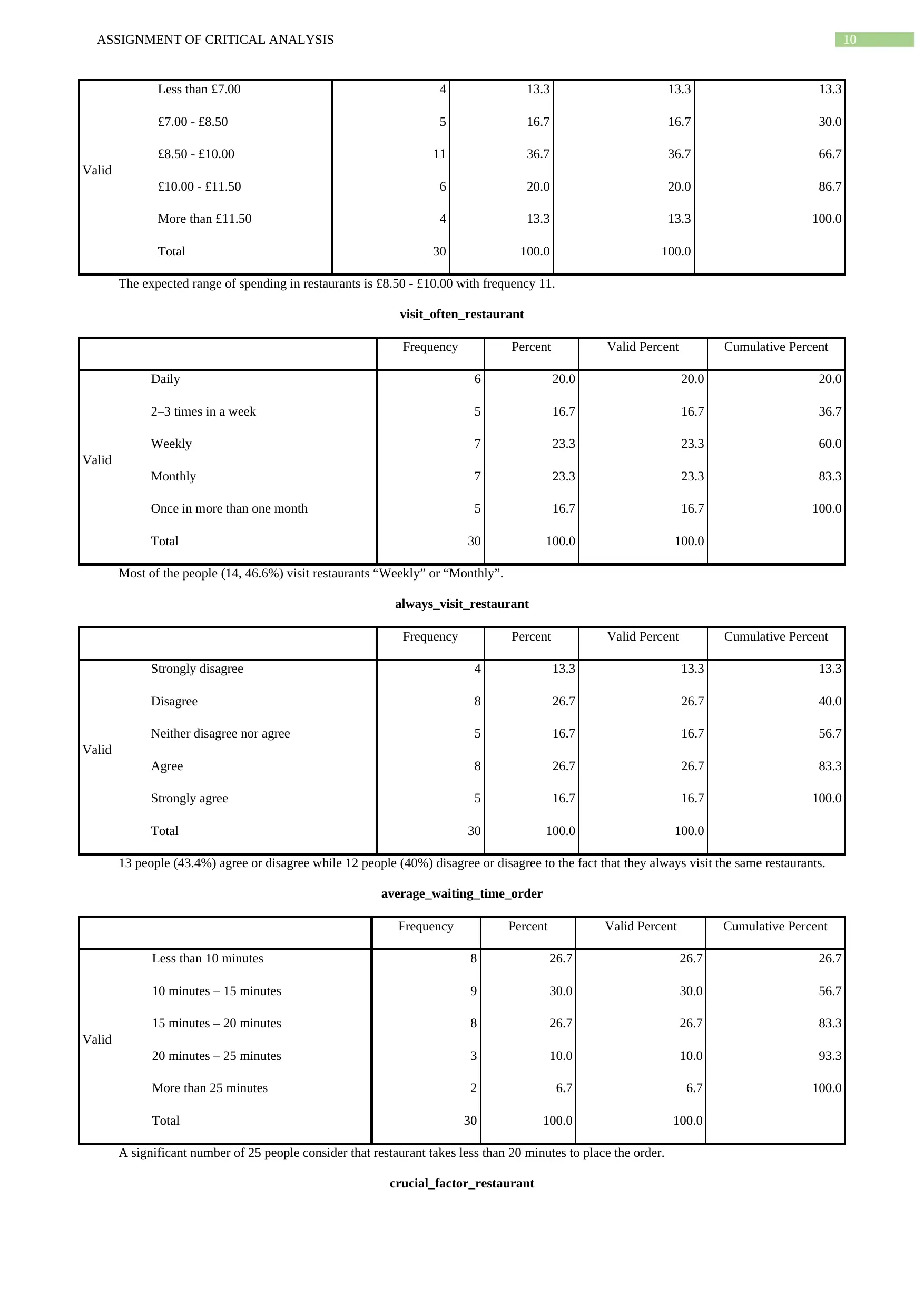
10ASSIGNMENT OF CRITICAL ANALYSIS
Valid
Less than £7.00 4 13.3 13.3 13.3
£7.00 - £8.50 5 16.7 16.7 30.0
£8.50 - £10.00 11 36.7 36.7 66.7
£10.00 - £11.50 6 20.0 20.0 86.7
More than £11.50 4 13.3 13.3 100.0
Total 30 100.0 100.0
The expected range of spending in restaurants is £8.50 - £10.00 with frequency 11.
visit_often_restaurant
Frequency Percent Valid Percent Cumulative Percent
Valid
Daily 6 20.0 20.0 20.0
2–3 times in a week 5 16.7 16.7 36.7
Weekly 7 23.3 23.3 60.0
Monthly 7 23.3 23.3 83.3
Once in more than one month 5 16.7 16.7 100.0
Total 30 100.0 100.0
Most of the people (14, 46.6%) visit restaurants “Weekly” or “Monthly”.
always_visit_restaurant
Frequency Percent Valid Percent Cumulative Percent
Valid
Strongly disagree 4 13.3 13.3 13.3
Disagree 8 26.7 26.7 40.0
Neither disagree nor agree 5 16.7 16.7 56.7
Agree 8 26.7 26.7 83.3
Strongly agree 5 16.7 16.7 100.0
Total 30 100.0 100.0
13 people (43.4%) agree or disagree while 12 people (40%) disagree or disagree to the fact that they always visit the same restaurants.
average_waiting_time_order
Frequency Percent Valid Percent Cumulative Percent
Valid
Less than 10 minutes 8 26.7 26.7 26.7
10 minutes – 15 minutes 9 30.0 30.0 56.7
15 minutes – 20 minutes 8 26.7 26.7 83.3
20 minutes – 25 minutes 3 10.0 10.0 93.3
More than 25 minutes 2 6.7 6.7 100.0
Total 30 100.0 100.0
A significant number of 25 people consider that restaurant takes less than 20 minutes to place the order.
crucial_factor_restaurant
Valid
Less than £7.00 4 13.3 13.3 13.3
£7.00 - £8.50 5 16.7 16.7 30.0
£8.50 - £10.00 11 36.7 36.7 66.7
£10.00 - £11.50 6 20.0 20.0 86.7
More than £11.50 4 13.3 13.3 100.0
Total 30 100.0 100.0
The expected range of spending in restaurants is £8.50 - £10.00 with frequency 11.
visit_often_restaurant
Frequency Percent Valid Percent Cumulative Percent
Valid
Daily 6 20.0 20.0 20.0
2–3 times in a week 5 16.7 16.7 36.7
Weekly 7 23.3 23.3 60.0
Monthly 7 23.3 23.3 83.3
Once in more than one month 5 16.7 16.7 100.0
Total 30 100.0 100.0
Most of the people (14, 46.6%) visit restaurants “Weekly” or “Monthly”.
always_visit_restaurant
Frequency Percent Valid Percent Cumulative Percent
Valid
Strongly disagree 4 13.3 13.3 13.3
Disagree 8 26.7 26.7 40.0
Neither disagree nor agree 5 16.7 16.7 56.7
Agree 8 26.7 26.7 83.3
Strongly agree 5 16.7 16.7 100.0
Total 30 100.0 100.0
13 people (43.4%) agree or disagree while 12 people (40%) disagree or disagree to the fact that they always visit the same restaurants.
average_waiting_time_order
Frequency Percent Valid Percent Cumulative Percent
Valid
Less than 10 minutes 8 26.7 26.7 26.7
10 minutes – 15 minutes 9 30.0 30.0 56.7
15 minutes – 20 minutes 8 26.7 26.7 83.3
20 minutes – 25 minutes 3 10.0 10.0 93.3
More than 25 minutes 2 6.7 6.7 100.0
Total 30 100.0 100.0
A significant number of 25 people consider that restaurant takes less than 20 minutes to place the order.
crucial_factor_restaurant

11ASSIGNMENT OF CRITICAL ANALYSIS
Frequency Percent Valid Percent Cumulative Percent
Valid
Price of food and drinks 3 10.0 10.0 10.0
Quality of foods and drinks 7 23.3 23.3 33.3
Location of the Restaurant 4 13.3 13.3 46.7
Calm Atmosphere and Cleanliness of the
Restaurant
11 36.7 36.7 83.3
Variety of menu of the Restaurant 5 16.7 16.7 100.0
Total 30 100.0 100.0
Most of the people (11, 36.7%) consider that the crucial factor of the healthy restaurant is its calm atmosphere and cleanliness.
reading_working_facility_restaurant
Frequency Percent Valid Percent Cumulative Percent
Valid
Strongly disagree 3 10.0 10.0 10.0
Disagree 5 16.7 16.7 26.7
Neither disagree nor agree 8 26.7 26.7 53.3
Agree 8 26.7 26.7 80.0
Strongly agree 6 20.0 20.0 100.0
Total 30 100.0 100.0
A significant number of 22 people do not incur the availability of reading and working facility of the restaurant.
technical_facility_restaurant
Frequency Percent Valid Percent Cumulative Percent
Valid
Strongly disagree 2 6.7 6.7 6.7
Disagree 2 6.7 6.7 13.3
Neither disagree nor agree 5 16.7 16.7 30.0
Agree 7 23.3 23.3 53.3
Strongly agree 14 46.7 46.7 100.0
Total 30 100.0 100.0
A significant number of 21 people directly agree about the fact that technical facility is present in the restaurant.
discount_facility_restaurant
Frequency Percent Valid Percent Cumulative Percent
Valid
Strongly disagree 2 6.7 6.7 6.7
Disagree 4 13.3 13.3 20.0
Neither disagree nor agree 5 16.7 16.7 36.7
Agree 9 30.0 30.0 66.7
Strongly agree 10 33.3 33.3 100.0
Total 30 100.0 100.0
Only 6 people think that their restaurants do not provide discount facility.
Frequency Percent Valid Percent Cumulative Percent
Valid
Price of food and drinks 3 10.0 10.0 10.0
Quality of foods and drinks 7 23.3 23.3 33.3
Location of the Restaurant 4 13.3 13.3 46.7
Calm Atmosphere and Cleanliness of the
Restaurant
11 36.7 36.7 83.3
Variety of menu of the Restaurant 5 16.7 16.7 100.0
Total 30 100.0 100.0
Most of the people (11, 36.7%) consider that the crucial factor of the healthy restaurant is its calm atmosphere and cleanliness.
reading_working_facility_restaurant
Frequency Percent Valid Percent Cumulative Percent
Valid
Strongly disagree 3 10.0 10.0 10.0
Disagree 5 16.7 16.7 26.7
Neither disagree nor agree 8 26.7 26.7 53.3
Agree 8 26.7 26.7 80.0
Strongly agree 6 20.0 20.0 100.0
Total 30 100.0 100.0
A significant number of 22 people do not incur the availability of reading and working facility of the restaurant.
technical_facility_restaurant
Frequency Percent Valid Percent Cumulative Percent
Valid
Strongly disagree 2 6.7 6.7 6.7
Disagree 2 6.7 6.7 13.3
Neither disagree nor agree 5 16.7 16.7 30.0
Agree 7 23.3 23.3 53.3
Strongly agree 14 46.7 46.7 100.0
Total 30 100.0 100.0
A significant number of 21 people directly agree about the fact that technical facility is present in the restaurant.
discount_facility_restaurant
Frequency Percent Valid Percent Cumulative Percent
Valid
Strongly disagree 2 6.7 6.7 6.7
Disagree 4 13.3 13.3 20.0
Neither disagree nor agree 5 16.7 16.7 36.7
Agree 9 30.0 30.0 66.7
Strongly agree 10 33.3 33.3 100.0
Total 30 100.0 100.0
Only 6 people think that their restaurants do not provide discount facility.
⊘ This is a preview!⊘
Do you want full access?
Subscribe today to unlock all pages.

Trusted by 1+ million students worldwide
1 out of 21
Related Documents
Your All-in-One AI-Powered Toolkit for Academic Success.
+13062052269
info@desklib.com
Available 24*7 on WhatsApp / Email
![[object Object]](/_next/static/media/star-bottom.7253800d.svg)
Unlock your academic potential
Copyright © 2020–2025 A2Z Services. All Rights Reserved. Developed and managed by ZUCOL.




